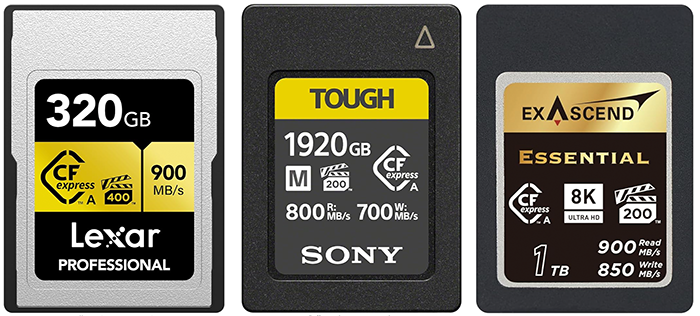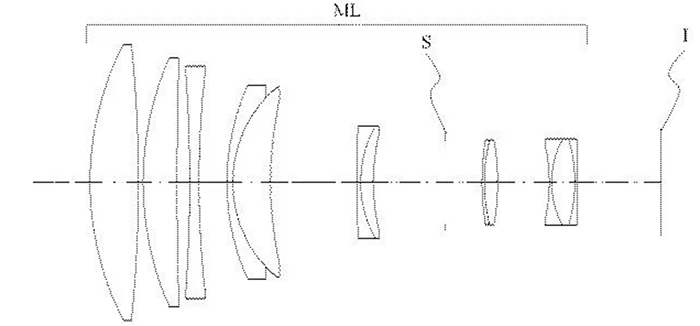Reviews of Samyang XP 85mm f/1.2 and comparison with Canon FD 85mm f/1.2 S.S.C. Aspherical
The following article is a guest post from Langstrum:
–
I live in South Korea and got a chance to have the new Samyang XP 85mm f/1.2 quite soon so I decided to make a user review and compare it to the [shoplink 54844 ebay]Canon FD 85mm f/1.2 S.S.C. Aspherical[/shoplink] as I have this lens for several years now. This review is based on the quality of a new copy of Samyang XP 85mm f/1.2 and a pristine copy of the FD lens (which is extremely hard to find now).
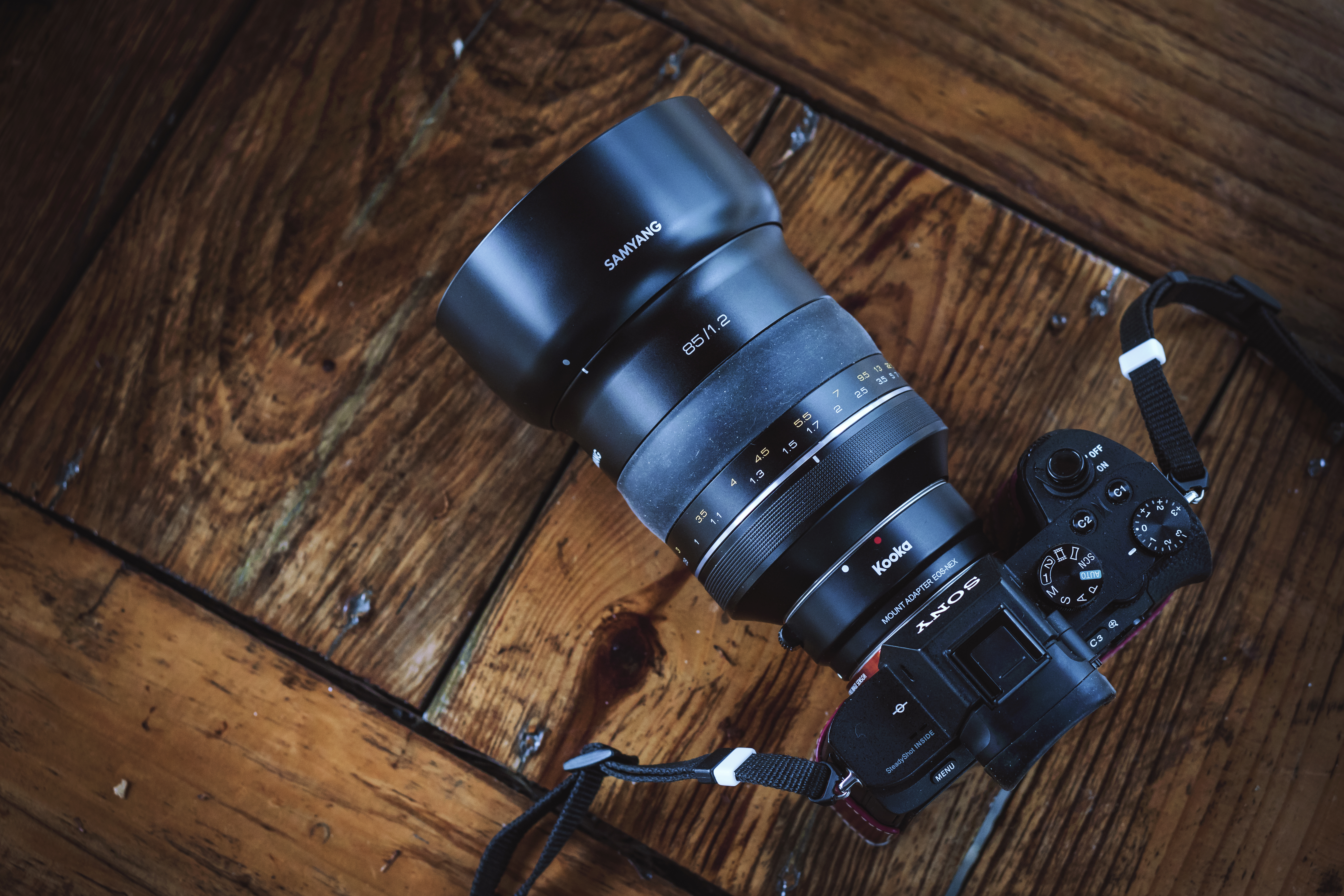
Why Canon FD 85mm f/1.2 S.S.C. Aspherical? Because it’s among the best pieces of glass that Canon ever made and the quality is comparable to the latest EF version (85mm f/1.2 L mark II). For the people who wonders if this version is better than the more common version FD 85mm f/1.2 L, the answer is Yes, because I own both and even though I didn’t compare them carefully, you can see the difference in this photo:

Now I’m going to quickly review the XP lens before coming to the comparison part. Some of the tests here will be repeated twice.
SAMYANG XP 85mm f/1.2 REVIEW
1. Technical features (in comparison with FD 85mm f/1.2 S.S.C. Aspherical) and handling

This lens is huge, it’s the biggest 85mm lens I’ve used and it’s both advantage and disadvantage to me as it feels sturdy and not shaking when I focus but I need to stretch my fingers to hold the lens and rotate the barrel. It’s built mostly with metal and the mount locks very tightly to the camera (well, actually in this case, it’s the adapter mount). Many people including me realized the resemblance with Otus 85mm in the lens appearance, especially when the hood is used. Anyway, it looks gorgeous, and you can guess the premium quality right away.
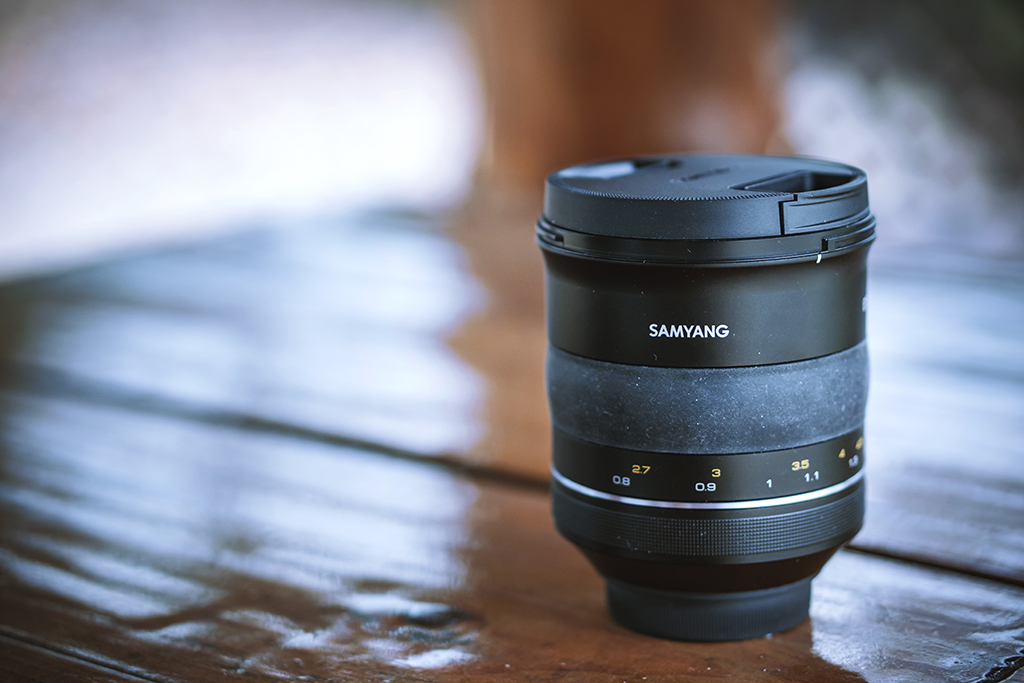
What I don’t like about this lens is the rubber ring. It feels good in my hand but it’s very dust-attractive and gets dirty very fast. Moreover, while the focus ring is smooth, it also can go pass the focus point easily, so I needed to practice for a while. The other thing I don’t like is the electronically-controlled aperture. While it’s easy, fast and accurate to set the aperture on camera body, it’s dependent on the camera. Currently Samyang only provides the Canon EF version of this lens and it means you only can control the aperture only with Canon cameras or AF adapters for Sony E mount or Micro Four Third cameras. I’m using Sony A7ii and I found out that half of my adapters can’t adjust the aperture of this lens. Viltrox II doesn’t show the F number and Techart EOS-NEX III can’t close the iris blades while I can set the number on the camera. There are two cheap adapters that I don’t frequently used are Kooka and Yongnuo (for APS-C cameras) but they can be used to control the aperture of this lens. I guess it’s not a problem with Sigma MC-11 and Metabones owners but I was a bit disappointed as I didn’t expect this issue with an MF lens.
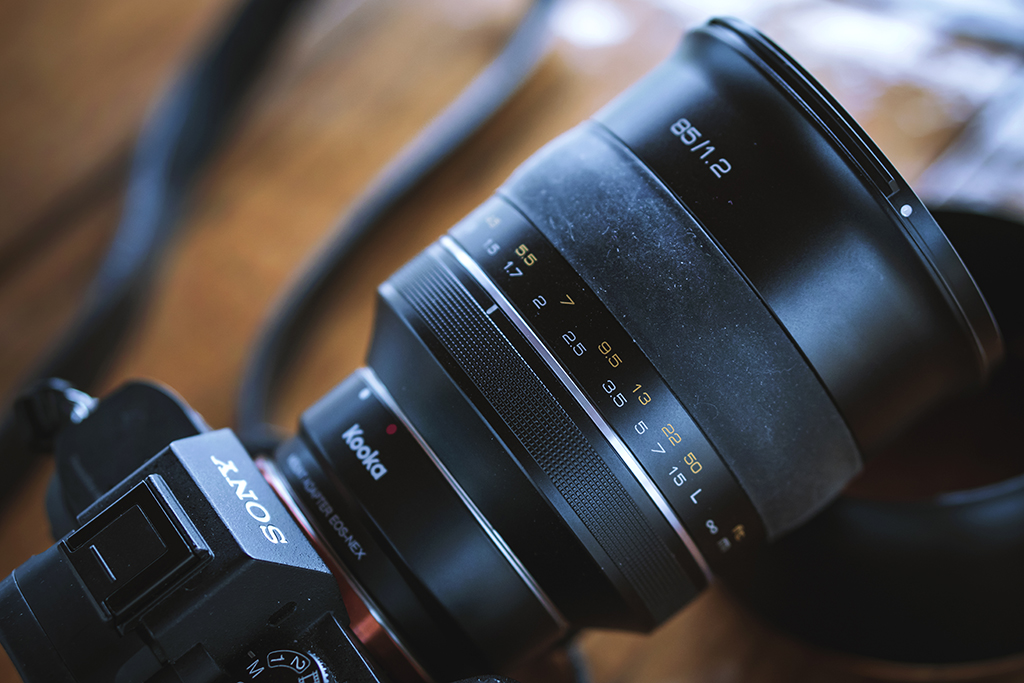
2. Sharpness, vignette and chromatic aberration
To compare the image sharpness with different F-stop settings, I fixed the camera position, turned off all the enhancement settings, used Aperture priority mode and didn’t use neither filter or hood. I shot in RAW and exported the photos to jpeg files for comparison.
The first one is the center sharpness. The large photos were shot at f/1.2 and f/3.5 when the vignette was at worst level and when it started to disappear, respectively. The small images below are the 300% crops of the center part of each photos shot at different apertures. You can see the sharpness is reasonable at f/1.2 and was improved slowly while the lens was stopped down all the way to f/8 and the diffraction came into play from f/11 downward and degraded image quality. Color fringing is there but it’s hardly noticed at the normal resolution and it’s gone completely from f/2.

The second one is sharpness of details close to the borders, corners. The details here are worse than the one in the center (but still looks good enough) and the level of color fringing is more pronounced. It seems the image sharpness drops only at f/16 and it always shows some level of chromatic aberration using all of the tested apertures.

3. Bokeh characteristics
 This lens produces smooth bokeh and in combination with the focal length effect of an 85mm lens, it’s very nice for taking portrait. The bokeh disc is perfectly round in the center and it changes to cat-eye shape near the corners. If the light source is not very strong, I can notice a bit of onion pattern, but in general it’s negligible. At f/2, the disc shape starts to show some edges, reflecting the blade arrangement in the diaphragm. I found it somewhat unsatisfied since the disc shape is not perfectly nonagonal and few blades in the bottom part are not very well assembled. This symptom may be varied depending on the copy, though. From f/3.5, the disc shape is obvious nonagon and depending on the light intensity, it can start to show some light leaking effect on the edges.
This lens produces smooth bokeh and in combination with the focal length effect of an 85mm lens, it’s very nice for taking portrait. The bokeh disc is perfectly round in the center and it changes to cat-eye shape near the corners. If the light source is not very strong, I can notice a bit of onion pattern, but in general it’s negligible. At f/2, the disc shape starts to show some edges, reflecting the blade arrangement in the diaphragm. I found it somewhat unsatisfied since the disc shape is not perfectly nonagonal and few blades in the bottom part are not very well assembled. This symptom may be varied depending on the copy, though. From f/3.5, the disc shape is obvious nonagon and depending on the light intensity, it can start to show some light leaking effect on the edges.
As a side note to achieve nice bokeh effect, if you shoot at high speed (around 1/2000 sec of faster) using a mirrorless camera, make sure you turned off the electronic first curtain or the bokeh disc will look incomplete like the one below and it will ruin a nice background you should have.

4. Distortion, field curvature and chromatic aberrations
As a mid-tele lens, this XP 85mm lens just shows little distortion and in reality it doesn’t affect the photo at all. However, I noticed some distorted field curvature and the level changes depending on the distance of the focus point. This field curvature is quite tilted with the left side is pushed backward more than the right side, suggesting some decentering of lens elements. It’s also not serious for taking portraits but you may consider it if you need to shoot a group of people or a flat subject at large apertures, the left and right corner may look softer than the center.


In term of chromatic aberrations, while purple fringing is almost zero at the focused details, it can be quite noticeable in the out-of-focus area, especially on the edges of high contrast details. This annoying chromatic aberration persists until f/3.5 and is almost gone when the lens is stopped down further. However, the level of chromatic aberration is only significant with high resolution images, it’s not a big deal with VGA-size photos.
You can see the changes in the level of chromatic aberration in the 200% cropped images below from the center of tested photos.

5. Comparison with Canon FD 85mm f/1.2 S.S.C. Aspherical
Before getting the new Samyang lens, I consider this FD lens is the best 85mm lens was ever made but I doubted that it still my king since it was produced around 40 years ago. Moreover, the floating design of this lens prohibits me from using extension tube for closer focus or use Techart Pro adapter for autofocus function (the image quality is degraded significantly when the lens is moved just a bit away from the distance it supposed to have to the sensor). I’m really interested in Samyang XP 85mm because of some initial impressive reviews and I had a high hope that the new lens can overcome some of the setback with FD lens that I don’t like.
I repeated the sharpness test and this time I shot both lenses with one scene and tried not to move anything from the set positions.
To my surprise, at f/1.2, the photos look almost identical in the center, except the color cast of Samyang lens was quite green and it’s more violet in the case of FD lens. Overall, the contrast of the photo produced by XP lens is a bit better and the center is tad sharper. Stopping down the lenses did increased the difference in the performance, favoring XP lens from f/3.5 onward and it’s more significant than wide open performance. Both lenses showed image degradation from f/11 due to diffraction.
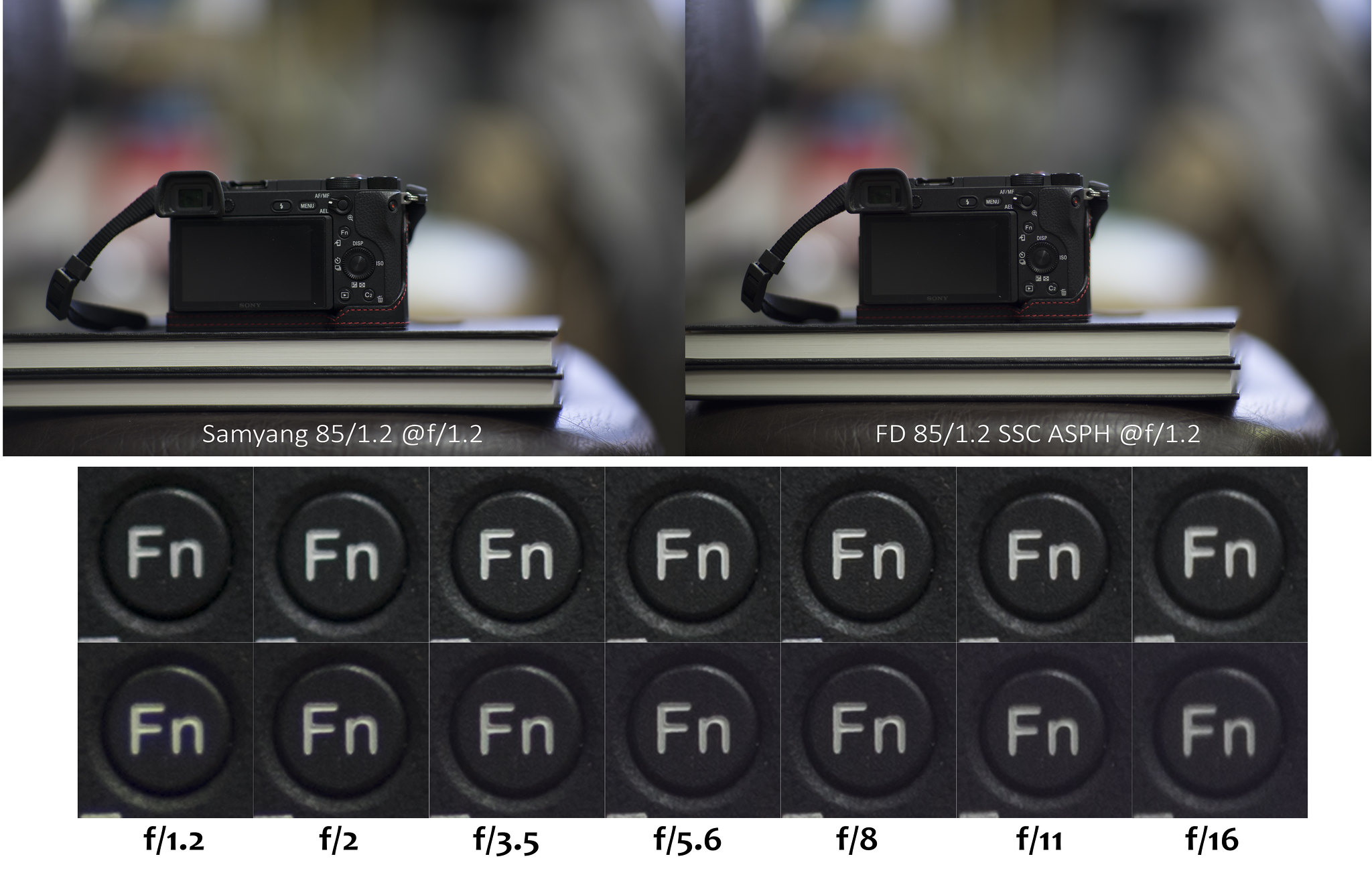
When I compared the border sharpness, the FD lens fared better with lower chromatic aberration and looked sharp from f/2 to f/11 while the image produced by Samyang lens was not very sharp until f/5.6 and the chromatic aberration is still there until f/11!
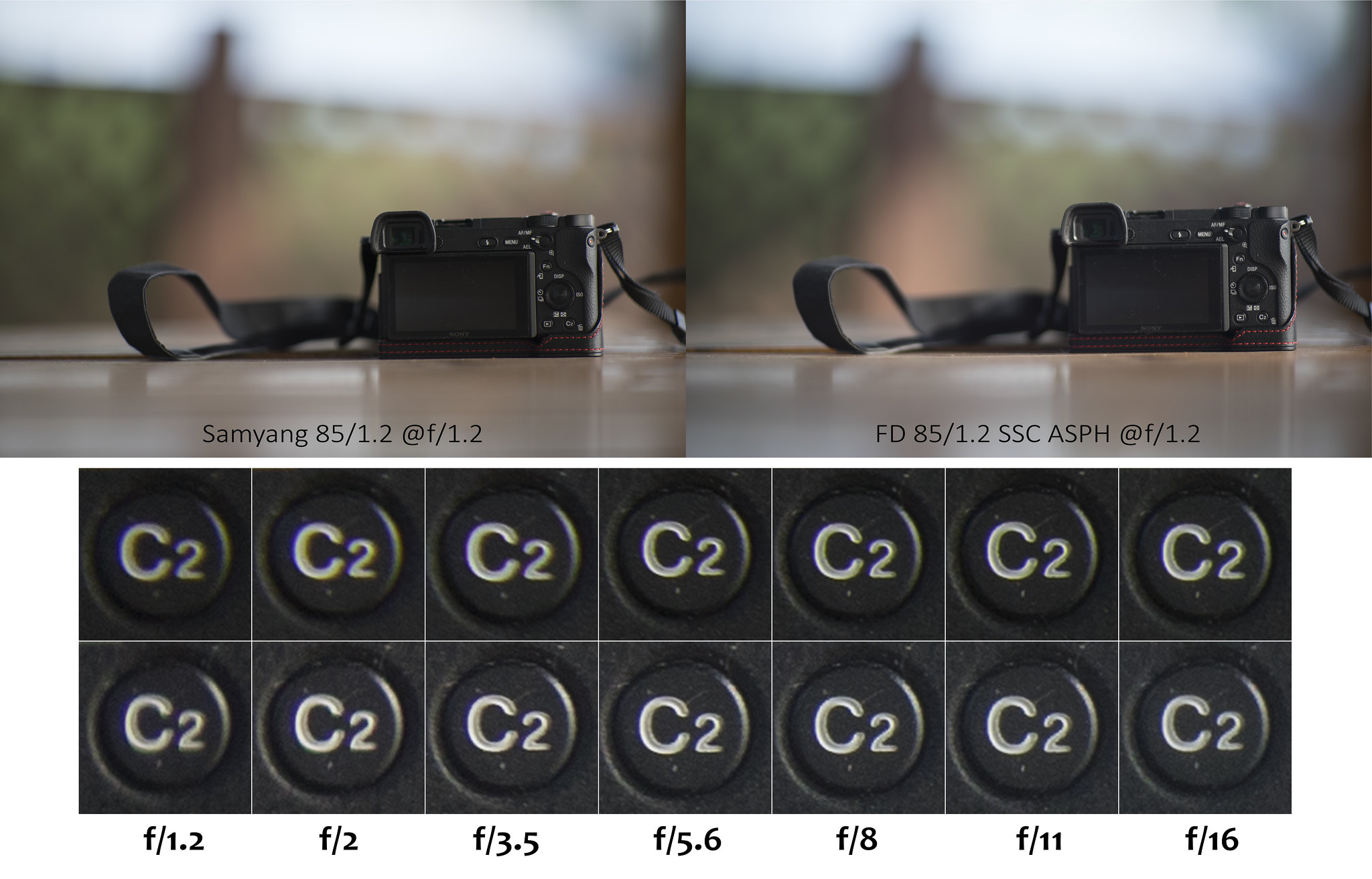
In the flare and ghosting resistance category, these lenses behave differently against strong back light with unique flare and ghosting effect. It’s not really any winner here but I prefer the flare of FD lens.

However, when I tested with dimmer back light (cell phone LED), I can see the difference that actually XP lens can resist the flare and ghosting better than XP lens. It’s shown by the better contrast nearby the light source and the absence of ghosting in the photo taken with XP lens on the left.
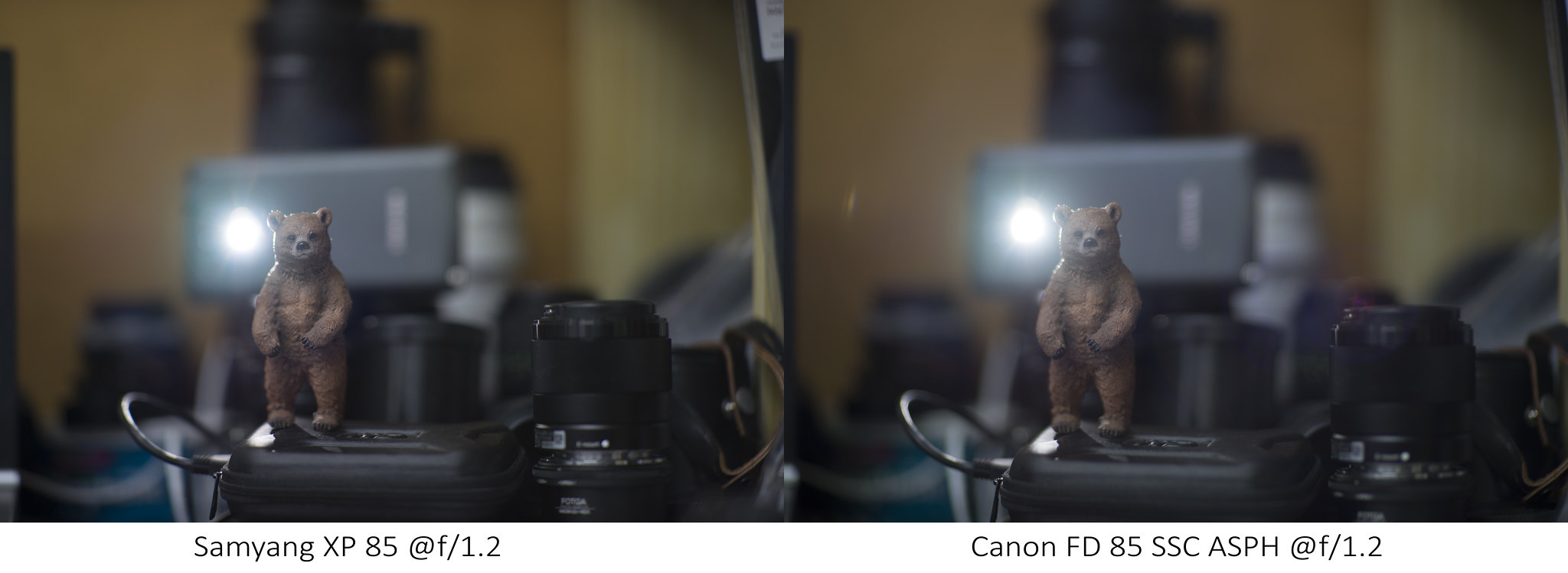
The last parameter I wanted to compare is the compatibility of these lenses with Techart Pro adapter for autofocusing on Sony A7ii. As I mentioned, I experienced quality degradation when I used AF function of Techart Pro with FD lens so I wanted to see whether the Samyang lens has the same issue or not since it’s not floating design nor internal focus. To do this test, I first turned off the AF function of Techart Pro adapter, so it retracted to the initial width and has the same flange distance as other Canon-Sony E adapters. I shot by manual focus and changed the focus point to far behind the first focus point and engaged Techart Pro AF function so that it pushed the lens forward to focus the first focus point. When the focus was achieved, the lens was actually at a farther distance to the sensor compared to normal manual focus method. I expected that Samyang lens may show no change in image quality but I was wrong, the level of quality reduction was even worse than FD lens even though the photo was still sharper.
With FD 85mm f/1.2
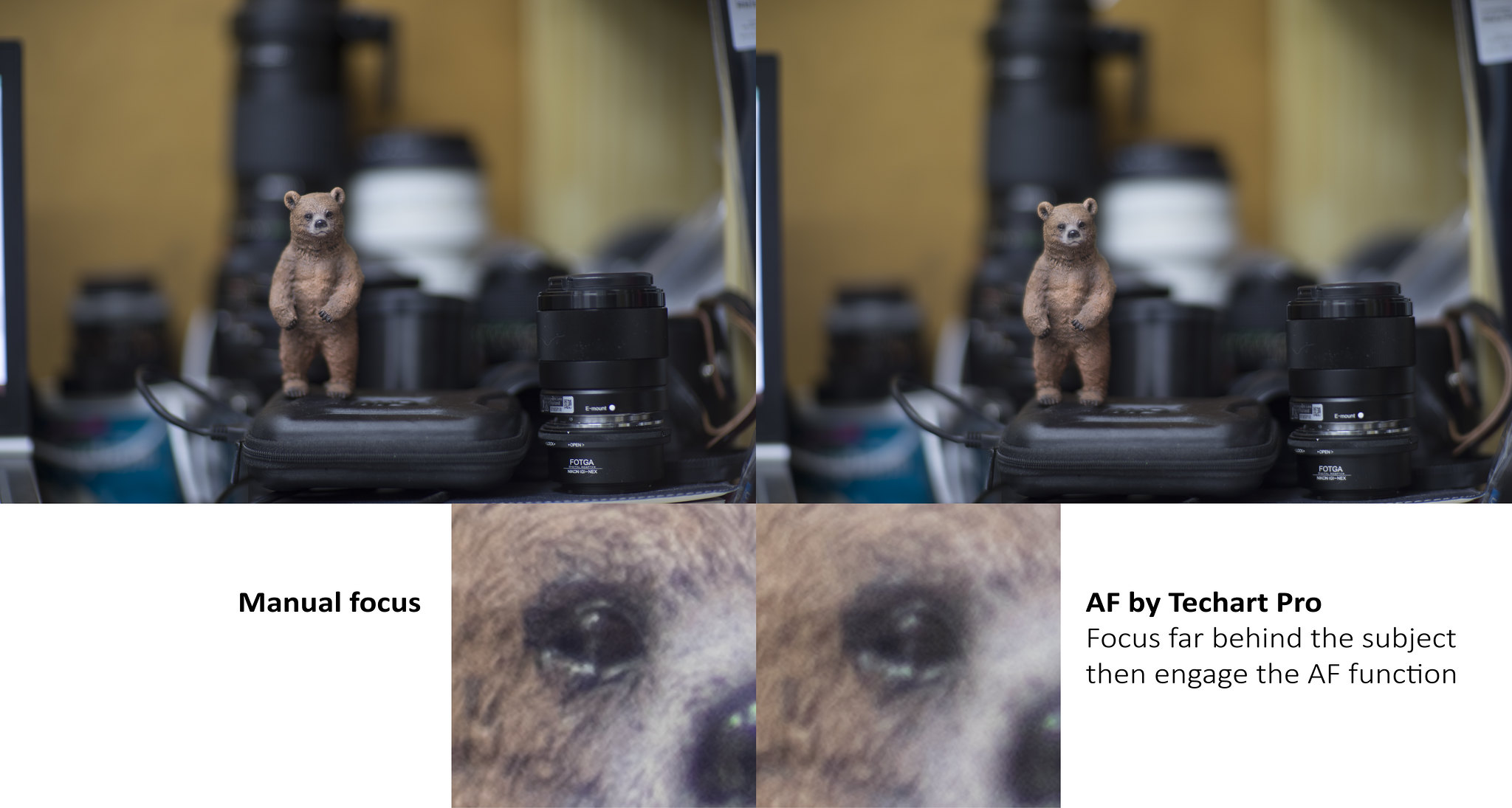
With XP 85mm f/1.2
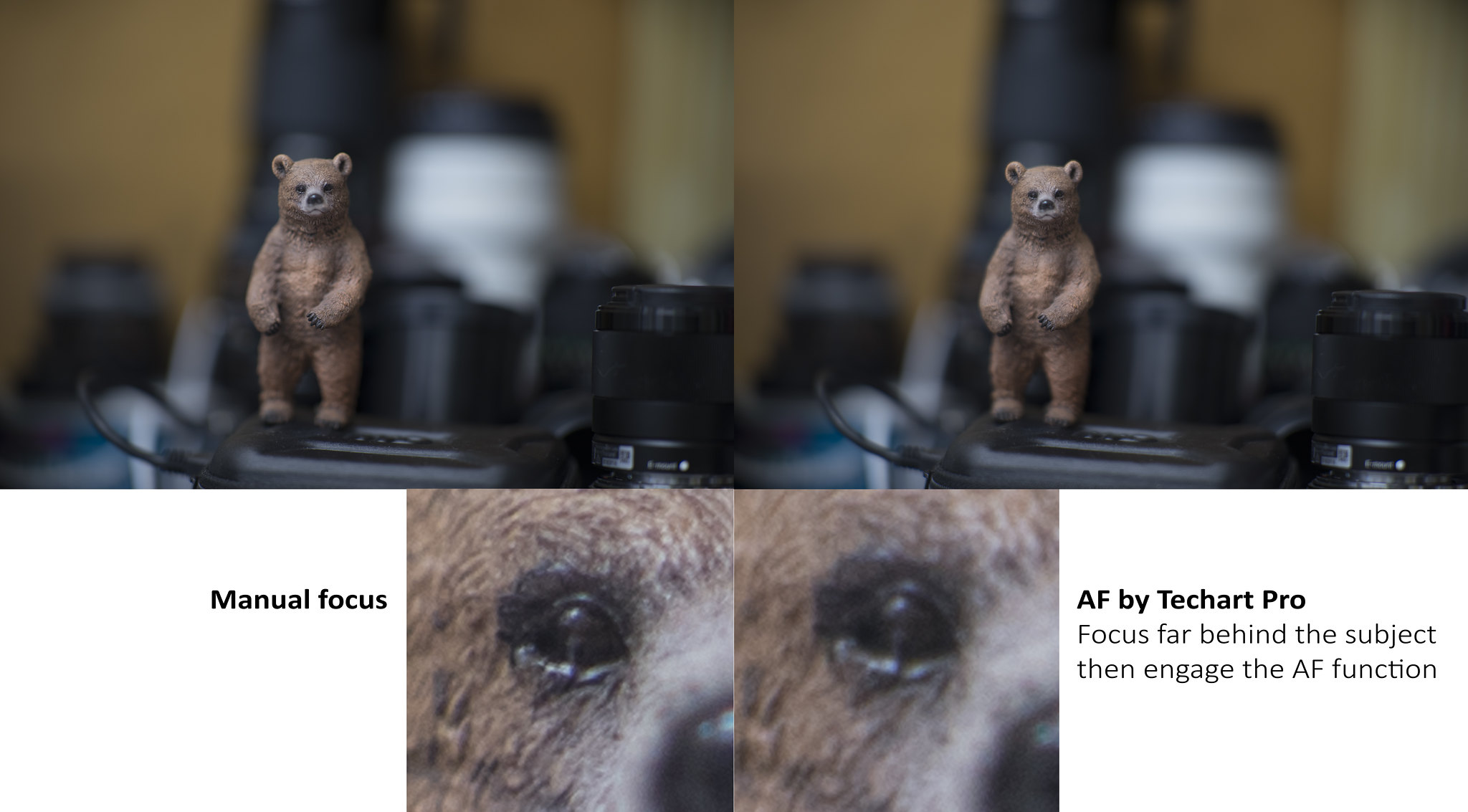
You may notice that the sharpness difference in these two images are significant, however, I shot differently with two lenses at varied distance and angles and there was some light from a laptop LCD nearby in front of FD lens while XP shot was not affected. The point is somehow XP performance is also highly dependent on the distance of the lens to the sensor and it seems Techart Pro is not recommended to use with either one of them. If you can accept a bit degree of image degradation, it’s better to achieve near-focus first by ful manual adjustment and let the adapter refined the focus point with AF function, so that the change will be not that much.
Someone may argue that heavy lenses are not suitable for using with Techart Pro and the adapter may be tilted during operation, but actually I’ve used this adapter with 1 kg and 3 kg lenses (EF 180mm f/3.5 L and FD 300mm f/2.8 L) and I found no difference in image quality as long as I use a tripod or my hand to support the lens from below. It’s the design of the lens that cause the image degeneration when it’s pushed away from the sensor. As evidence, take a look at the result of a similar test I did with EF 180mm f/3.5 L.

6. Conclusion and photo samples
My first impression with this XP lens when I first got it and did some testing shots was WOW, it’s sharp and the bokeh is smooth. My impression was confirmed after careful examination and comparison with my beloved FD 85mm f/1.2 S.S.C. Aspherical. They’re very resembled in real life shooting and I only can recognize the photos I shot with XP lens by quite sharper details in 100% crop, a bit warmer in white balance and more pronounced chromatic aberration in the out of focus area. They both produce smooth bokeh and be able to capture gorgeous photos. While I really like the impressive performance of Samyang, I have to, again, admire the quality of the 40-year-old lens made by Canon, it’s still a tough oldie. Technically XP lens is better in most major parameters but it’s not really much in real usage and now I have to keep both lenses until I can make up my mind since Canon lens even though is tad worse, is smaller, doesn’t require any electrical contact to the camera and has high collection value.
Maybe your observations and opinions will be different from mine so I would like to listen to more feedbacks to get better next time I examine lens performance. And the last part is photo samples that I took mainly at f/1.2 to f/2 straight out of camera (SOOC) and some were post processed in Photoshop to fit my style. For high quality photos, you can refer to my Flickr accounts in here and here and watch in full resolution.
XP 85mm, f/1.2 SOOC




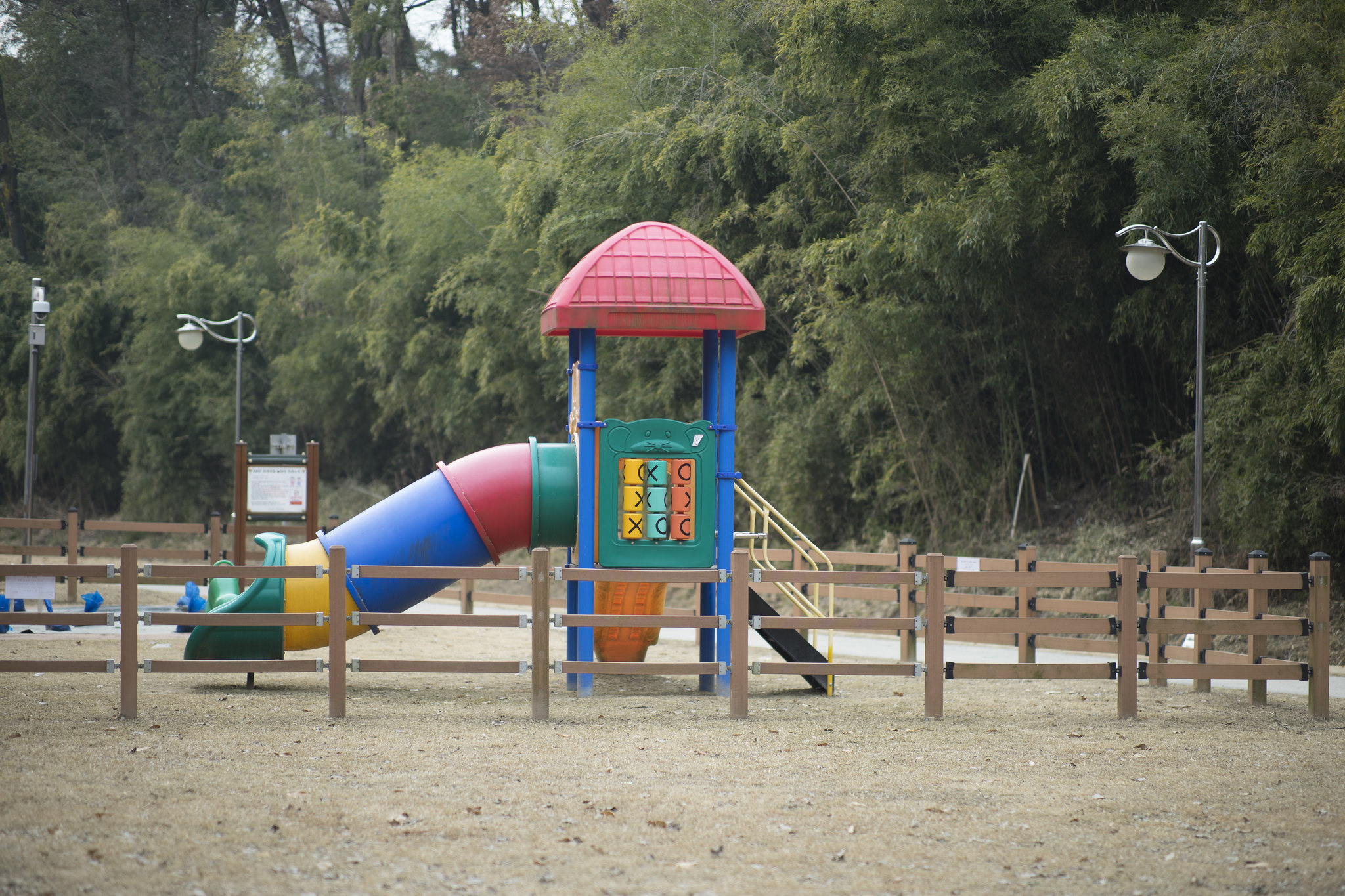

XP 85mm, f/1.4 SOOC


XP 85mm, f/2 SOOC

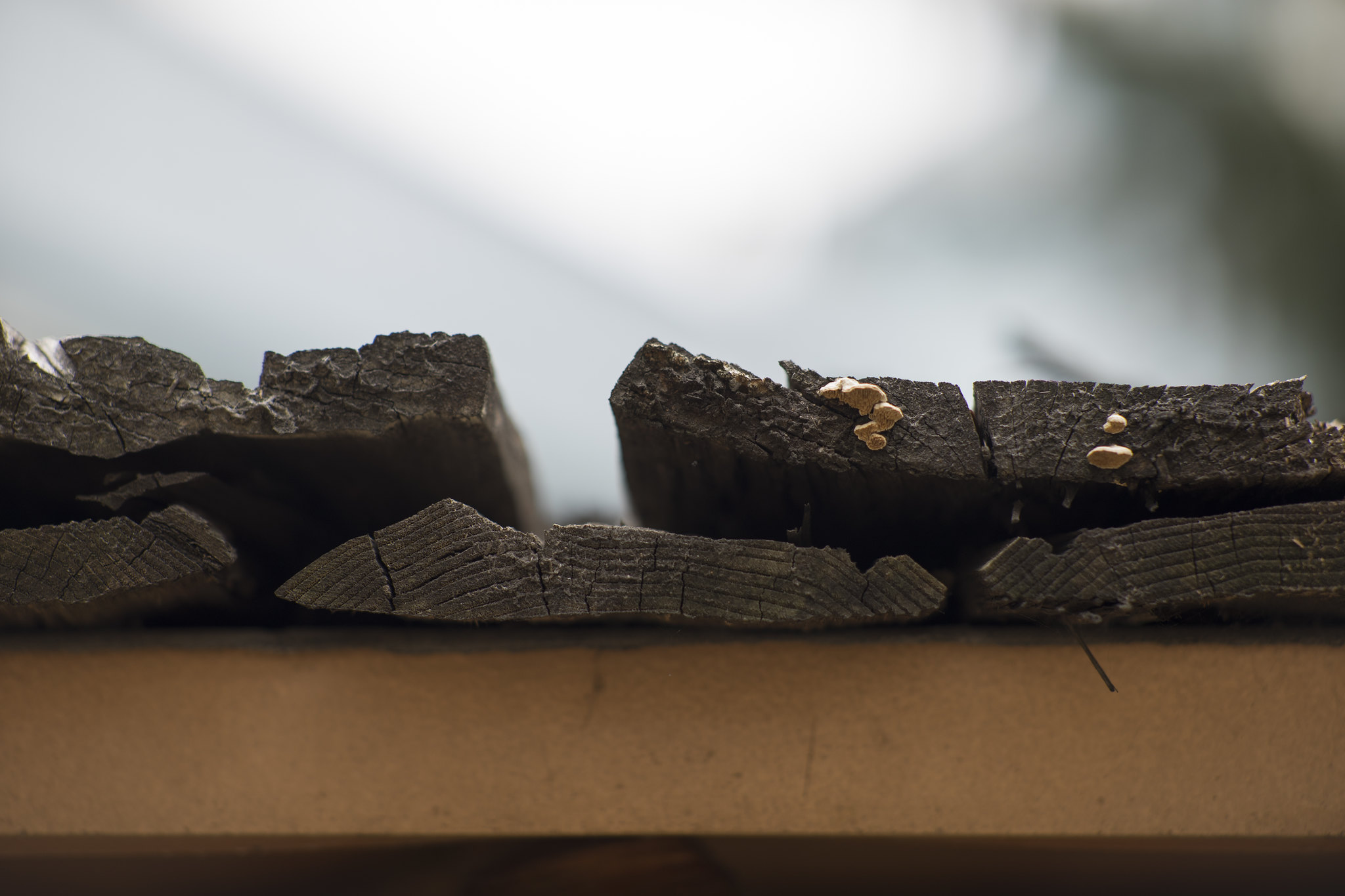
XP 85mm, f/1.2 (post-proceeded)




And lastly, some photos I took with FD 85mm f/1.2 S.S.C. Aspherical




